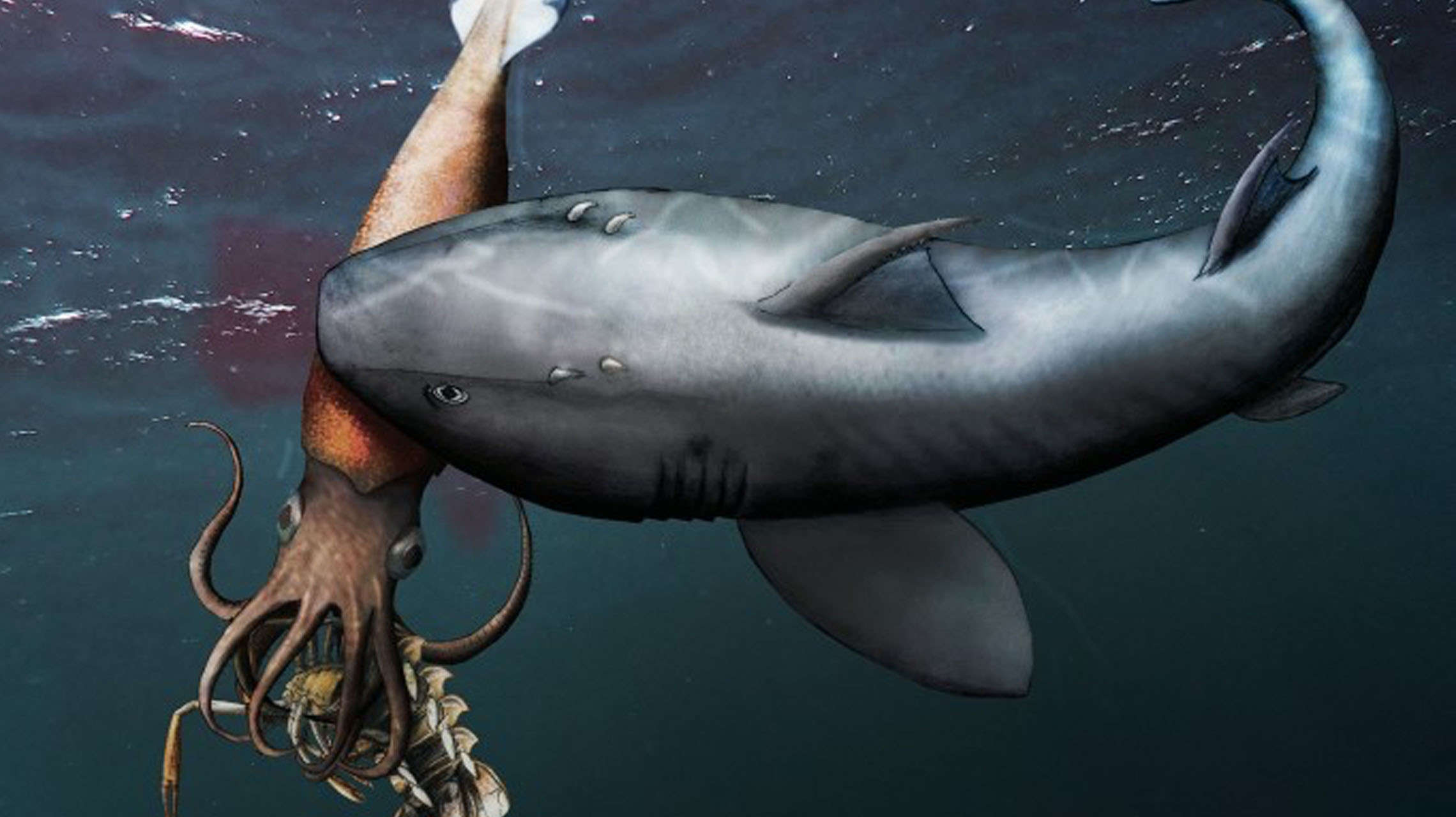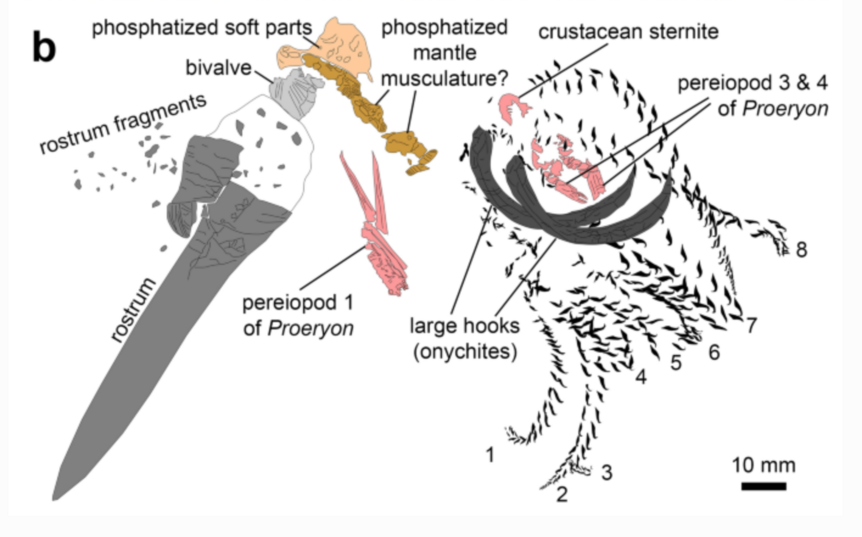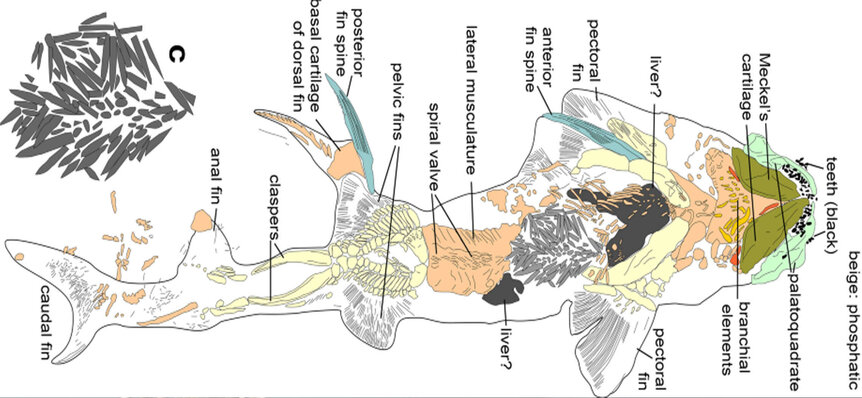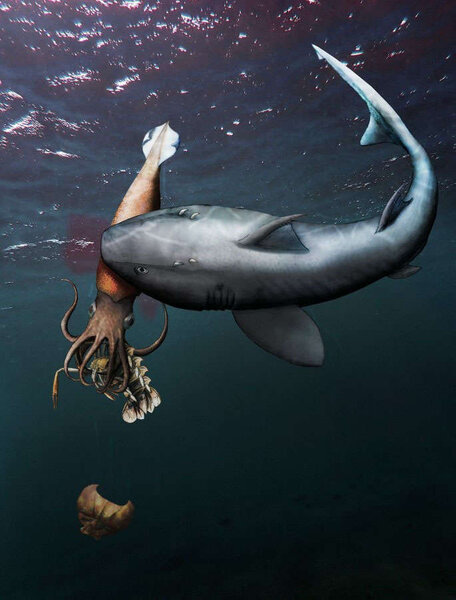Create a free profile to get unlimited access to exclusive videos, sweepstakes, and more!
Turducken has nothing on this fossil of a shark eating a squid eating a crustacean

Around 180 million years ago, a proto-squid caught a lobster-like thing that it was just about to feast on when something made a meal of the unwary squid.
Whether it was hunger that made the squid (really an extinct creature called a belemnite) drop all its defenses and ignore predators, we will never know, but being buried on the seafloor for millions of years in that position created a fascinating fossil. Though the predator that bit off a mouthful of squid was not fossilized with its prey, it is likely to have been a Jurassic shark that would eat belemnites by the dozen. This really is kind of like a prehistoric version of turducken.
Evidence for how predators hunted in ancient seas is not easy to come by. Paleontologist Christian Klug, a professor at the University of Zurich’s Paleontological Institute who is also curator of the University of Zurich’s Paleontological Museum, knew that predation frozen in time like this was something to sink your teeth into, even if evidence for who the largest predator was remains indirect.
“It is remarkable that leftovers are actually interesting sources of palaeobiological knowledge,” Klug, who led a study recently published in Swiss Journal of Paleontology, told SYFY WIRE. “The only direct evidence we can possibly get for predator-prey relationships is stomach and gut contents, or when distinct imprints of jaws allow taxonomic assignment of the predator or when teeth still stick in the prey. Such cases are quite rare."
This is a type of fossil known as a leftover fall, which captures a predator’s ancient leftovers that sank to the bottom of the ocean. The belemnite Passaloteuthis laevigata was unfortunately never able to get even a mouthful of the crustacean it had just caught, so the lobster-thing is referred to as a pabulite, or a fossilized meal that never got eaten — those that were eaten and often found as stomach contents are referred to as regurgitalites. Pabulites can tell scientists about details of predation that would have otherwise been lost to time.
Cephalopods are mostly made of soft tissue that degrades easily, either, which makes this fossil even more of a find. Many of them regulate how buoyant they were in water by using ammonia, which is supposed to make preservation less likely. The belemnite couldn’t have used ammonia to stay afloat since it ended up preserved so exceptionally. Though the meal it would never eat was not in such great condition because it appears to have been molting, it is still well preserved for what it is. Other things revealed more about this belemnite to Klug and his team.
“What is also interesting is that the habitats of these three groups of animals (shark, cephalopod, crustacean) must have overlapped,” he said. “If the crustacean was benthic, the belemnite must have approached the ground occasionally. The shark was fast enough to catch the belemnite, probably in the open water."
So who was the perpetrator? While this will probably remain a cold case where the murderer is involved, the most likely suspect is the shark Hybodus hauffianus. It is notoriously difficult for sharks and other elasmobranchs to fossilize because their skeletons are made of cartilage instead of bone. The predator either swam away or sank, but decomposed. A previous fossilized specimen of this shark (below) shows that it overindulged in belemnites to the point that its stomach became clogged with them, which is probably what killed it.
Klug believes that H. hauffianus and other predators had learned exactly how to tear off a piece of squid — by staying away from the beak and snapping up the soft parts. The squid fell apart, and the way the fossilized fragments were positioned suggest that it wasn’t caused by sediment getting compacted in the process of fossilization, but happened before it landed in its final resting place. That still tells us something about how hunting went down in the perilous waters of the dinosaur age.
“Many predators were quite opportunistic in their choice of prey,” he said. “It had to be easy to catch (no waste of energy), it should not be too dangerous (poison, risk of getting injured by spines or teeth), its size had to fit the mouth and jaws, and it needed to be digestible.”
Next time you end up with leftovers to freeze for later, just think of that shark. At least yours didn’t end up fossilized.





























